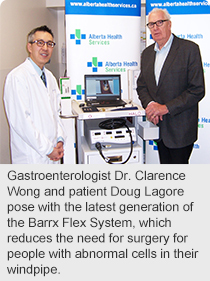
January 8, 2015
Story and photos by Shelly Willsey
Doug Lagore is starting his retirement without cancer or surgery worries.
Lagore, 71, was diagnosed with Barrett’s esophagus in 2011 – a condition that develops when years of acid reflux cause the esophagus to become inflamed. If untreated, the condition can lead to cancer. Lagore now undergoes outpatient treatment every six months.
He is among hundreds of people in the Edmonton area who will not require surgery to remove cancerous or pre-cancerous cells in their esophagus thanks to new, leading-edge technology at the Royal Alexandra Hospital.
Through a $200,000 donation from the Royal Alexandra Hospital Foundation, the hospital recently acquired the latest generation of the Barrx Flex System, which enables more patients to undergo a minimally invasive procedure called ablation that uses radio frequency energy to destroy abnormal cells.
“I’m told the tissue in my esophagus was as close to being cancerous as it could be,” says the Spruce Grove man. “For me, the treatments are pain-free, with no side effects, and I believe they’ve saved me from battling cancer.”
Ten years ago, nearly all patients with cancerous or pre-cancerous cells in their esophagus underwent surgery. Today, about 200 patients every year will receive ablation treatment rather than surgery – a 20 per cent increase with the new Barrx Flex System.
“This machine allows for the greatest variety of sizes and lengths of tubes available, so we can treat patients we couldn’t have previously,” says gastroenterologist Dr. Clarence Wong.
“Sometimes people have different anatomy or scar formations that would have prevented radio frequency ablation with the older catheters. They would then require surgery. With this machine, we can now reach almost all diseased areas.
“This is also good news for the health system. The more patients who can undergo ablation means more surgical capacity is freed up for Albertans who need it.”
The surgical option, called an esophagectomy, requires the removal of all or part of the esophagus, followed by one or two days in the intensive care unit and a seven- to 14-day hospital stay. Surgeries require more care, longer recoveries and have a higher risk of complications.
By comparison, ablation involves insertion of a catheter through the mouth that is then guided by camera to the esophagus. A radio frequency generator heats the catheter, which can be used to destroy abnormal cells while sparing healthy tissue. Typically, the entire procedure – from arrival to discharge – takes about two hours and patients can return home the same day fully functional and with only mild discomfort.
After the abnormal tissue is initially removed, patients return every three to six months for followup treatment, often avoiding chemotherapy and radiation treatments.
Foundation President and CEO Andrew Otway says a new Barrx machine was identified as a top priority by the hospital.
“So much of health care is driven by technology, and the Royal Alexandra Hospital Foundation is always eager to fund new medical technology at the Royal Alex Hospital,” says Otway.
“We’re glad our support has helped make this purchase a reality.”